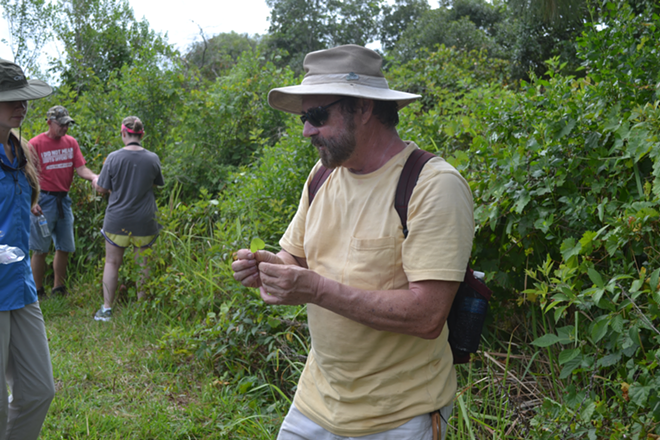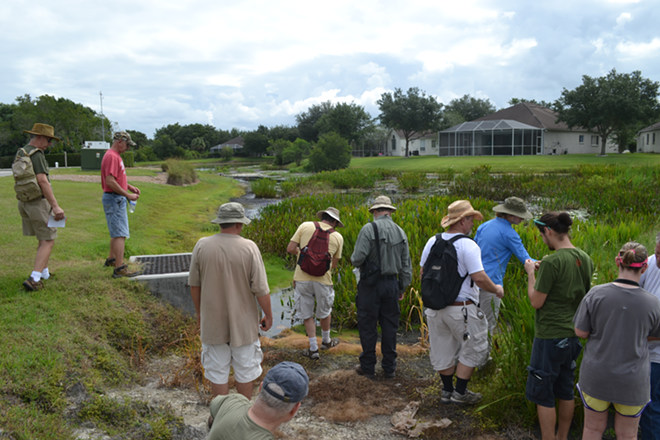“Green Deane” Jordan has been foraging for wild edibles since his childhood days in the woods of Maine.
When questioned by a student in his foraging class last Sunday about how he got started, he smirked and said, “With my mother, every meal was either a burnt offering or a sacrifice, so I learned to find my own food pretty young.”
Besides providing him with ample wit and sarcasm, a lifetime of foraging, researching and cross-referencing has made 64-year-old Deane a walking encyclopedia on eating wild things. He could give Euell Gibbons a run for his money as educator and entertainer. He touts that his Youtube channel, now featuring 126 episodes of Eat the Weeds, has the most views of any foraging channel in the world.
In between filming new episodes, writing posts for his website and keeping up with the thousands of emails people send him, Deane makes time to travel up and down Florida teaching classes, giving his fans a chance to learn, taste and bounce stupid questions off of him in person.
The class on Sunday was held outside of a community club in Highwoods Preserve in Tampa. Though not technically a park, the large green area surrounding the club provided plenty of diversity for foraging. The class was $30 a head.
Sixteen enthusiasts showed up for the four-hour lesson that blended science, survivalism and the culinary. All of them seemed familiar with Deane’s work, and many knew quite a bit about foraging themselves, but they were excited to be in the presence of the master.
Deane led us on a pleasant hike around the edges of the country club, alongside a road and drainage ditch, and on a foot trail around the edges of a pond. Within that relatively small area he pointed out more than 50 edible species in dry, moist and wet environments.
Many of his plant descriptions came with backstories, from Native American history to the Greek mythology behind scientific names. Chief Osceola’s name, Deane related, roughly translates to “he who throws up a lot.” The Seminole tribe used yaupon holly, a native Florida plant, in a concentrated decoction meant to purge and purify the drinker, by way of vomiting, earning it the scientific name Ilex vomitoria.
“History is interesting, sometimes,” Deane said as an endcap to the story.
Another lesson learned from Jordan’s class was not to trust any supposed “common knowledge” when it comes to foraging. Like that one that seeing a bird eat something in the wild means it’s safe for people, too — turns out that’s wrong, and in some cases, dead wrong. Deane explained that each animal has its own unique set of foods that it can and can’t digest. For example, humans are one of the only animals that can eat avocado.
Some of the most interesting edible and useful plants we saw included:
Skunk vine (Paederia foetida): Nutritionally like broccoli, this plant gets its name for all the reasons you might think, though Deane thinks there are smellier plants out there. He recommends cooking the leaves outside to avoid sulfur bombing your house or infuriating a roommate, though the brave can eat the leaves raw. Skunk vine is not a native plant; it was brought to Florida to make rope.
Wild Blackberries (multiple species): There are multiple varieties of these in Florida, some that grow on an upright stalk, or cane, and some that have vines that crawl along the ground, known as dewberries. Fruiting around this time of year, the berries (usually black when ripe, though they can be red or yellow) are small but taste sweeter than many store-bought blackberries. Leave some for the birds! The leaves of the plant can be used for tea.
Water Hyssop (Bacopa monnieri): Extremely bitter, this plant grows in moist soil and has been used for ages in India to improve memory function. It can be dried and brewed as a tea, eaten raw, cooked, or used in a tincture with, say, vodka.
Yaupon Holly (Ilex vomitoria): Although NONE of the berries on native Florida hollies are edible, the leaves of the yaupon holly contain high amounts of caffeine and antioxidants, making them perfect for tea (vomiting only occurs from consuming an extreme concentration). Deane said that some of his braver friends simply chew the leaves when they don’t have time to stop and boil water on hikes.
Beauty Berry (Callicarpa Americana): The berries of this plant are bland eaten raw, but can be jellied. A recipe can be found on Deane’s website. The leaves can be crushed up and rubbed on skin for bug repellent, and when dropped into water, they can stupefy fish. Endless fish tank amusement.
Among the less savory plants Deane pointed out during the class were slow killers, like dog fennel, that would not affect most people after a few ingestions but cause slow buildup toxicity in the body; (relatively) instant death plants, like water hemlock and castor bean; and “famine foods,” or plants that you could eat if necessary for survival but that might have some negative side effects, like Caesar weed.
He also discussed calorie-positive versus calorie-negative foods. If someone was truly in a survival situation, some plants are not worth eating because they take more energy to prepare than the energy recouped from eating them.
There were a fair share of plant puns and jokes from Deane along the way, some of them actually useful. “Sedges have edges, reeds are round, and grasses like asses have holes,” he recited, after confirming that no children were in the group.
The class wrapped up with a question-and-answer session in the parking lot. Deane answered questions freely but made clear the limits of his knowledge, deferring to other sources on topics such as herbalism.
“My goal as a forager is to use a plant and not be reminded of it later,” said Deane. “A herbalist on the other hand is looking for a specific reaction from the plant.”
The class was slow to disperse, and would have probably hung around for as long as Deane kept sharing his knowledge.
You can get a greater taste for foraging by scouting out a few of Deane’s videos and visiting his website, where he has lots of information for beginners, Q & As, and a handy itemized foraging system, as well as his class schedule. He typically makes it to the Tampa Bay area at least twice a year, but it’s worth a drive farther north for one of his classes. Foraging is an extremely seasonal pursuit so the plants you see will vary greatly depending on the time of year. If you go, bring water, a notepad, and a willing tongue.



